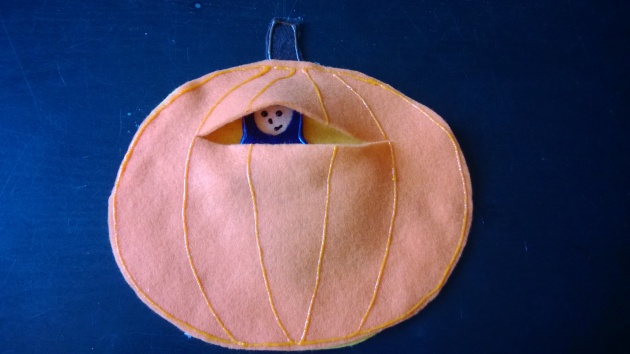The Pumpkin Child is an old Persian folktale, and I really like it. It's sort of like a cross between Cinderella, Ugly Duckling, and a gender-bent Beauty and the Beast. There is humor, as the storyteller describes the pumpkin rolling and bumping around, but also we feel sympathy for the Pumpkin Girl, and a big theme of the story is how she copes with being different and made fun of (her mother tells her as she leaves for school, "Ignore anyone who makes fun of you!")
Like Cinderella, the Pumpkin Girl must be identified by an object that fits only her-a ring. Only in this tale, it's not a commentary on tiny size being ideal, but simply the fact that the Pumpkin Girl is unique. Some girls tried to starve themselves to get their fingers the right size, but others tried to fatten themselves up.
Murad, the rich merchant's son, has an advantage in that he saw a beautiful girl come out of the pumpkin and reenter, so he knows there's a secret this Pumpkin Girl has. Yet, he is not entirely selfish. His bride does not transform right after the wedding. In fact, he suffered some of the same mockery of the villagers once he declared his intentions to wed a pumpkin. After the wedding, he "took his pumpkin bride far away where he cared for her and never allowed anyone to laugh at her." I love this idea that, yes it's love that set her free, but not a one time love showed just by a proposal-he showed steadfast love over time and it was that love that set her free.
Image from here- to accompany the folktale "The Singing Pumpkin"
Read the whole tale here! This website also includes a family activity to go with the stories, this one is making pumpkin chips!


A bit strange, though. The pumpkin is a native plant of North America. How long ago would it have reached Persia?
ReplyDeleteThat is a very good question and I have no idea...whenever we read tales around the world that have been translated into English there's a good chance that Western culture had already influenced the stories somewhat before they were recorded. which is why we sometimes see Cinderella stories in Africa, etc. But as the commenter below indicates, being in pumpkin form is not necessarily essential to the story, she could be a pig or some other form
DeleteThere is a Hungarian cartoon resembling that story, except with a pig instead of a pumpkin.
ReplyDeleteWatch it here: https://www.youtube.com/watch?v=G-lHXVk2bfM
Thanks! That little pig is so cute! Although it appears in the Hungarian story the transformation happens right after the wedding. But it was well done-I could understand pretty well what was going on even without English translations!
DeleteYep, the Red Pig is the Hungarian version of the same tale :) I have heard it in a number of variations. When the transformation happens depends on the telling. I am glad you liked the story! I love telling it.
DeleteI think I've found another favorite fairy-tale. :D This story is fun, and when I read it aloud to my younger sisters they enjoyed it so much! Like you, I love how it's an enduring, steadfast love that frees the pumpkin girl.
ReplyDeleteIt could have been another kind if squash, one native to the middle east, and a translator at some point changed it to 'pumpkin'. Maybe because the image of a pumpkin rolling off to school is seems so comic.
I love that you read this to your little sisters! And you're right, I think the image of a pumpkin rolling to school is definitely funnier than a lot of other vegetables would be :)
DeleteI also like two other things about this story:
ReplyDelete1. The merchant's son needs to try the ring on all the girls not because he doesn't know what his beloved looks like, but because he is not allowed to enter the houses to see unwed girls face to face. Makes a whole lot more sense than Cinderella :)
2. The beginning, in which the father runs away and never comes back, creating one of the few instances in fairy tales where a widow is raising her only daughter with love and care (as opposed to single fathers with girls or single mothers with boys, which are a lot more common)
Yes! You mentioned the first point in your post, and that was one of the things that made me interested in reading the whole tale! And I didn't even think about the positive female relationship-that's huge!
DeleteKristin, I am a professional storyteller and want to address your comment of Western civilization impacting other cultures, re: Cinderella. There are over 500 variants of Cinderella from around the world, one of the oldest is Yeh Shen from China, it is over 2000 years old. Western civilization did not influence other countries, rather they influenced ours. There are always variants of folktales from other countries, much older than ours.
ReplyDeleteThank you for your comment! In my previous comment, I didn't mean to imply that all fairy tales originated in Western culture, which is certainly not true and likely not true for Cinderella in general, but just responding to a reader's insightful question about how a tale about a pumpkin showed up in Persia (I had no idea myself where pumpkins grow naturally!). In that instance it could have been influenced by travelers from other parts of the world. When English readers read tales translated from other languages there has already been the Western influence, in some way, of the translator themselves, so sometimes that explains how cultural details go both ways. But thank you for pointing that out! I wouldn't want to mislead anyone
Deleteyeet
ReplyDelete